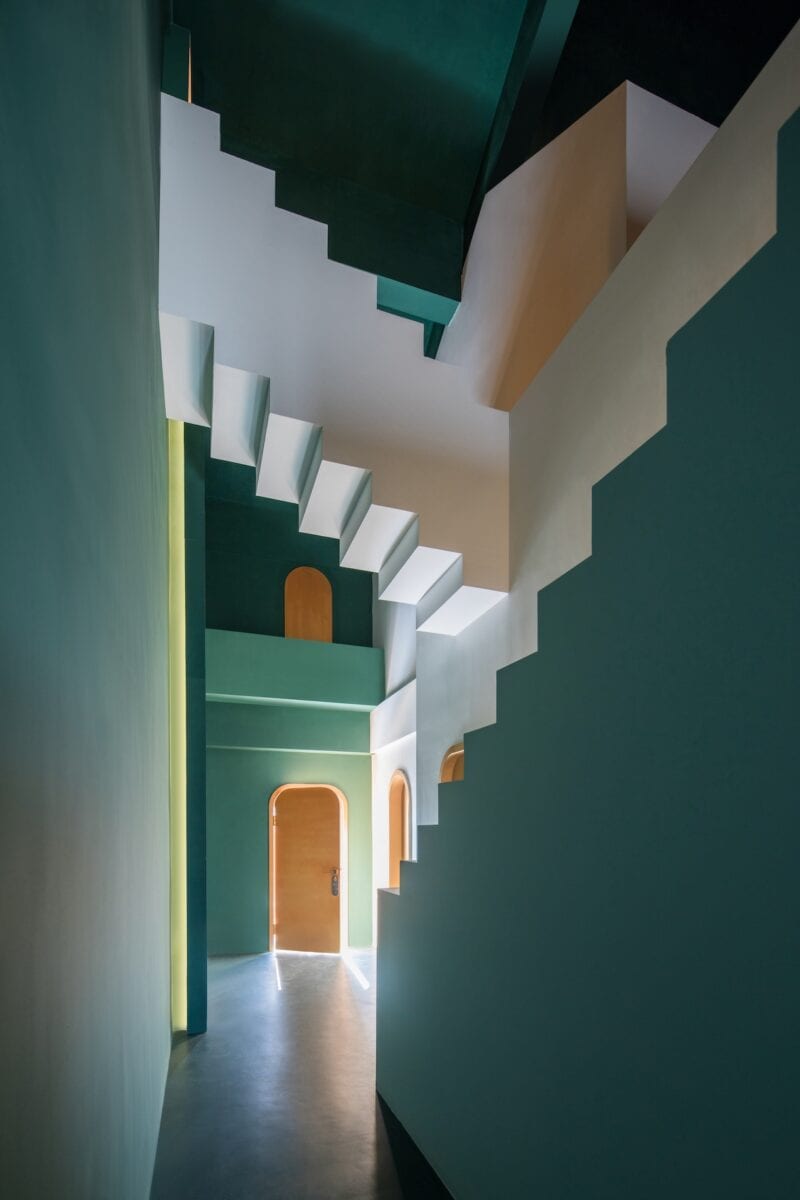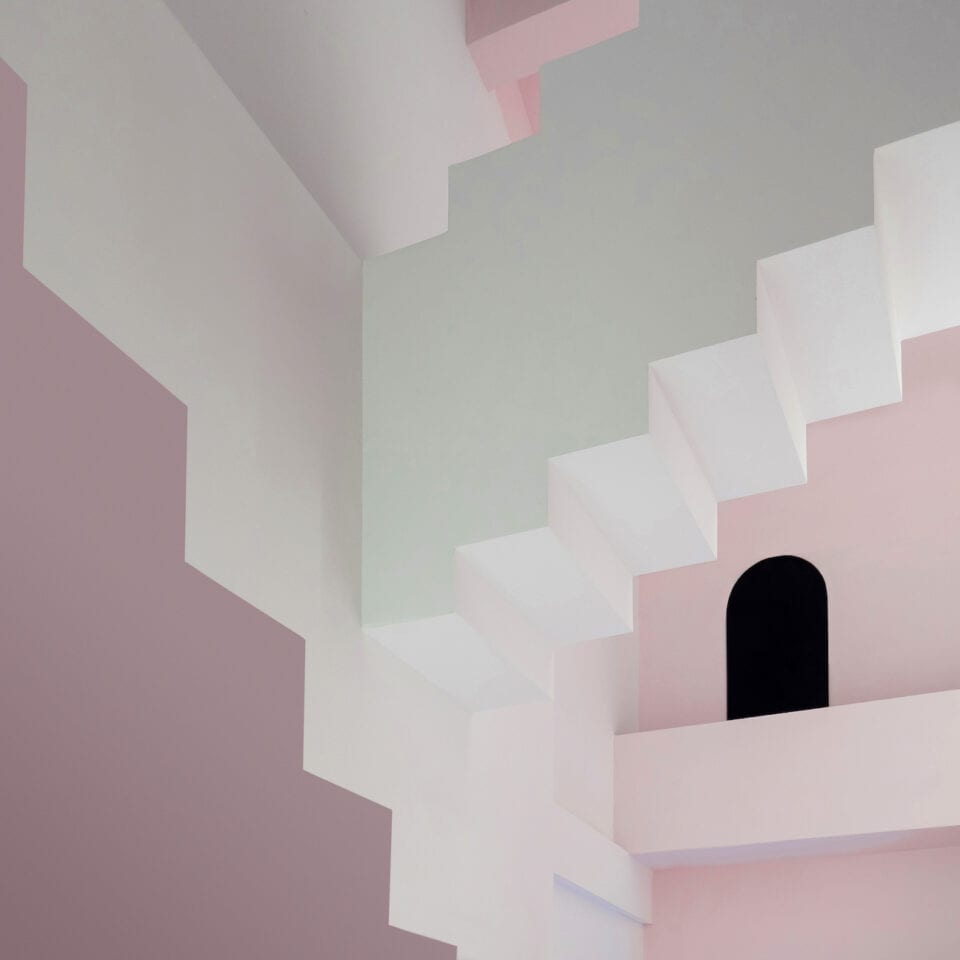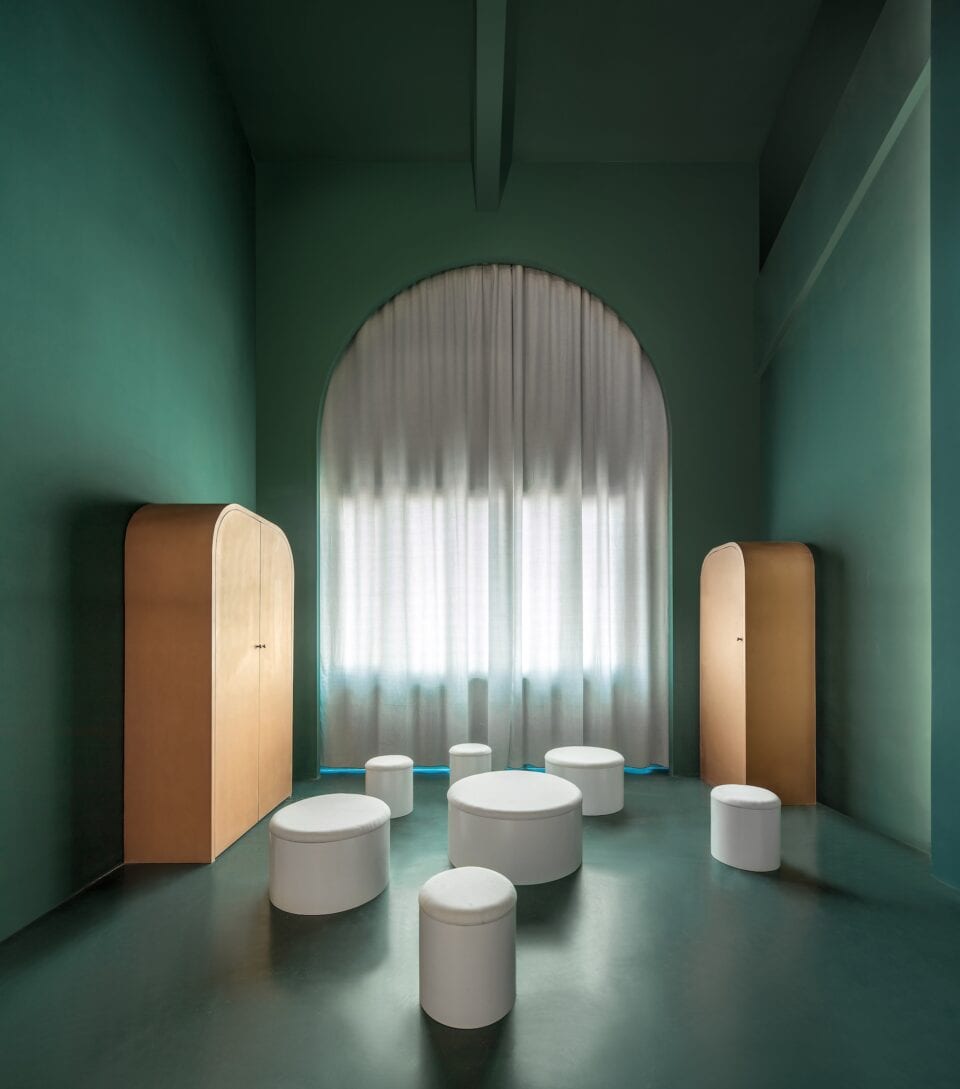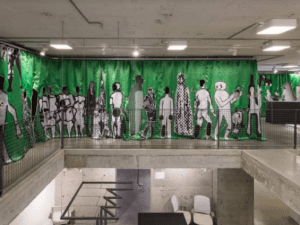The kaleidoscope of stairwells and doorways that crowd the interiors of the Other Place guest house, on the banks of the Li River in Guilin, serves as a metaphor for the period of tumult and opportunity amongst China’s architectural com- munity: it’s not clear where the route forwards lies, but the state of confusion is somehow enticing. The Maze and Dream guest house suites (pictured here) were modelled on MC Escher’s impossible landscapes – designed to trick the eye.
The scale of recent and projected building work in China is jaw-dropping, as the China editor of Wallpaper*, Yoko Choy Wai-Ching, relays in her introduction to Beauty and the East. “In the last 70 years, the number of cities in China has risen from less than 60 to 672. By some estimates, almost half of the world’s construction will take place in China in the coming decade.” And that’s in a country which already “builds 22 billion square feet of new floor space each year – if it was laid out flat, that would be 1.3 times the size of the entire footprint of London.” Infrastructural development on this scale brings obvious challenges. China’s ongoing reliance on energy-intensive materials such as steel and concrete has grim implications in an era of climate crisis. More practically speaking, as Choy notes pithily in interview, “it doesn’t make sense any more to build shoddy stuff in China.”
In other words, there are also questions about the quality of construction that takes place when the pace of expansion is so fast, as summarised by the head of iconic firm Amateur Architecture Studio Wang Shu in his foreword to the Gestalt- en book. “Until the end of the 1990s there were essentially no independent architectural practices in China as the state-owned mega design institutes dominated.” As the country became rapidly urbanised “these institutes were drawn into a whirlpool of large-scale developments – the number of projects was giddying, and the requests relentless … It was almost impossible to produce good quality architecture.”

Although the number of private firms has multiplied over the last two decades, the legacy of that first, dizzying, “ex- perimental” era of Chinese architecture is evident in the im- possibly truncated planning and construction schedules still foisted on most firms. Wang Shu points out that a proposal “conventionally takes half a year.” But Chinese clients “will only allow two months, so things proceed in feverish haste. Very often, drawings are rendered without a thoroughgoing design proposal. In truth, most constructions in China start before the completion of the drawings.” Roughcast spaces, misplaced switches and sockets, irregular rows of windows – in short, “bad” architecture – are all symptomatic of the fact that “everything was designed and constructed in a hurry.”
Against this backdrop, however, an alternative paradigm has emerged, powered by the rise of private firms of varying sizes and types, albeit in a space still mediated by the demands of the state. Wang Shu’s Amateur Architecture Studio is the great pioneering force here. Responsible for some of the most iconic recent Chinese building designs, such as the Ningbo Historic Museum and the Fuyang Cultural Complex, the studio has forged an aesthetic based on repurposing materials and structures, as well as a reliance on traditional construction methods, and forging links with local historical and environmental heritage. What’s more, when Wang Shu became the first Chinese architect to win the prestigious Pritzker Prize – the so-called “Nobel Prize of Architecture” – in 2012, he placed not just Amateur Studio but the country’s broader design achievements under the global spotlight for the first time. “From Wang Shu I see a new start,” Choy muses positively, “a starting point for people to look at Chinese architecture overall, and city planning; he has also inspired a lot of new generations.”
Pressed on the other most significant firms of the still- blossoming independent era, Choy mentions practices with a mixture of western and national influences. MAD Architects, whose founder Ma Yansong is Yale-educated, is one of the first Chinese firms to secure major European commissions, and is now designing the FENIX Museum of Migration in Rotterdam. “He is the first to be entrusted with a public cultural building on the continent. It’s a huge mile- stone.” By contrast, the founder of LUO Studio, Luo Yujie, studied in China and has specialised in rejuvenating rural villages. “From his work you see something authentically and organically Chinese.” Choy is referring to works such as LUO’s Party and Public Service Center in Yuanheguan Village, Hubei Province, a beautifully spare functional structure created by repurposing the abandoned steel- and-concrete foundations of a half-finished residential project – adding a timber-framed upper storey.

Choy’s selection of two such different visions is not ac- cidental. She pushes back against the idea of any common thread underpinning contemporary Chinese architectural philosophy: and given the sheer size and diversity of the country’s population, its diffuse geographies and social milieux, and an increasing openness to international influences, she clearly has a point. Perhaps the only common contextual factor to the projects in Beauty and the East is awkward interdependence with the state, which is still relied upon for conceptual validation, as well as legal and eco- nomic gate keeping. As Choy puts it, “to execute new concepts, you need to get local government on board.”
The country’s built environment is a subject upon which the authorities continue to weigh in heavily. In 2015, the national State Council issued a decree on the desirable qualities of urban architecture: “suitable, economic, green and pleasing to the eye,” in contrast to the “xenocentric, peculiar” developments of the previous decades. The pro- jects in the state’s crosshairs might have included Beijing’s China Central Television headquarters (known as the “Giant Underpants”), designed by the Dutch firm OMA in 2012. The year before the directive was issued, State Premier Xi Jinping had famously called for an end to “weird architec- ture,” with such extravagant foreign projects surely in mind.
This level of government control has undeniable up-sides too. For example, it has allowed funding to be channelled away from sprawling megalopolis developments such as along the Pearl River Delta, ensuring – as far as possible – that regional towns and villages also remain lively eco- nomic and cultural centres. The achievements of Amateur Architecture Studios, whose many projects have encouraged a sense of pride amongst depleted rural communities, are unavoidably entwined with this narrative. So too are the fortunes of other firms such as DnA, whose renovation of ancient villages in Songyang County – funded by the local government – involved planting a cluster of brand new industrial structures across the region, produced on time-honoured construction principles: a process referred to in this publication as “architectural acupuncture.”

This brings us round to the dazzling portfolio of projects in Beauty and the East, an encyclopaedic survey compiled by in-house editors at Gestalten with Choy’s advisement, in which the reuse of existing materials and structures and reliance on traditional methods are recurring motifs. Think of Atelier tao+c’s Capsule Hotel and Bookstore in Qinglongwu Village, Zhejiang Province, built into a traditional rural structure with mud walls and a timber-framed shell, with inner spaces remodelled and a glass-panelled gable-end added to create a gorgeous, sun-flooded chapel for browsing and reading.
Or take Studio Zhu-Pei’s Imperial Kiln Museum in Jingdez- hen, which incorporates a set of long, low arched vaults mir- roring the structures of the abandoned kilns on whose sites they sit, using bricks reclaimed from the old ovens. Then there’s anySCALE’s Wuyuan Skywells Hotel, a renovated 300-year-old mansion with a modern penthouse and origi- nal wooden decorations restored by a local artisan. In anoth- er breath HyperSity Architects’ refashioned cave dwellings (yaodong), in the Loess Plateau region, are created using rammed-earth; whilst O-office Architects’ Lianzhou Museum of Photography is built on the site of an old sugar warehouse.
In other cases, modern structures are inserted into spaces between older buildings, like PAO Studio’s “plug in” steel capsules, that slot into the central courtyards of antique urban siheyuan dwellings; or their Shangwei Village Plug- In House, designed to rejuvenate dilapidated dwellings in villages engulfed by the expansion of Shenzhen on the Pearl River Delta. The examples are myriad, and the outcomes of this impulse to “make new” are often remarkably scintillating.

Again, for Choy, we shouldn’t take this as evidence of a “national style” so much as common limits on resources and time. Like LUO Studio’s community centre, many of the designs reflect the scant materials, technology and workforces available to deliver a brief on a tight schedule. “In villages like Qinglongwu, where the Capsule Bookstore was built, architects face a lot of constraint in terms of availability of materials, building technologies and so on. The reality is that often the clients aspire to good design in these areas, but they offer little time and budgets.” It’s overcoming these restrictions – not an interest in combining the traditional and the modern, or eastern and western influences – that will define the eventual look and feel of a building: “for me meaningful architecture just has to solve problems.”
All of the examples listed above might prompt readers to risk a definition of contemporary Chinese architecture as ecologically driven, sensitive to cultural imagination and memory, and mindful of the need to reuse rather than tear down and start from scratch. China continues to consolidate its position as the central player in the global economy, and there is cause for cautious optimism about the broader implications of this, not least for international progress on environmental sustainability and social planning.
“You can see that the government is jumping on the opportunity for leadership created by the absence of the US in these discussions,” Choy notes, alluding to the Trump presidency. “But for a lot of creative people I talk to in China, it’s not about power and control: they genuinely think that they can share the experiences, knowledge and insights that they have gained from this crazy period of urbanisation to reach out to a global audience, to help everyone.”
Words: Greg Thomas
Beauty and the East is published by Gestalten. uk.gestalten.com
Image Credit: Studio 10, Photo Chao Zhang, Beauty and the East, gestalten 2021.





